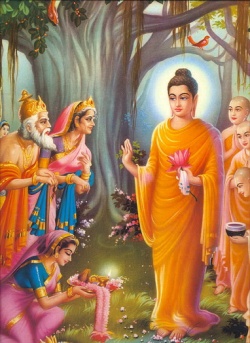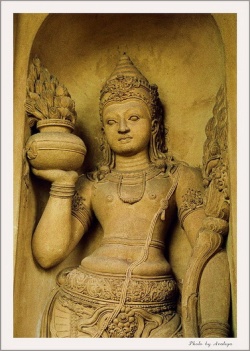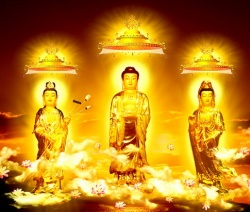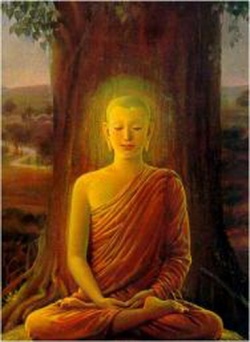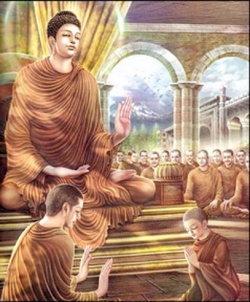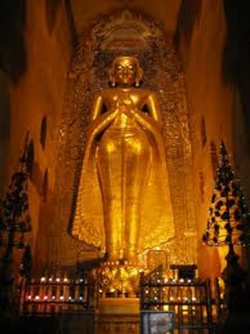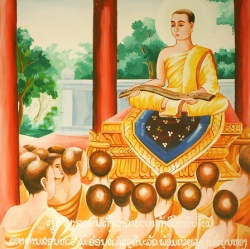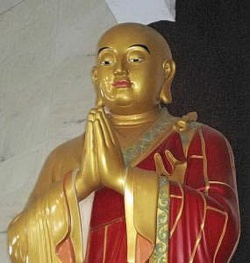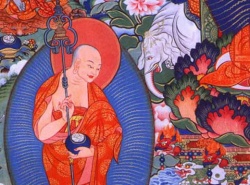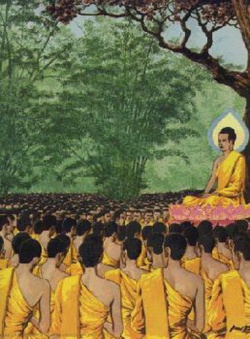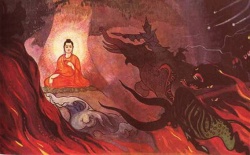Third Council – Third Dhamma Sangayana
THAT redaction of the true dhamma, which was arranged at the beginning by the great theras Mahakassapa and others, is called that of the theras. One and united was the school of the theras in the first hundred years. But afterwards arose other schools of doctrine[1]. The heretical bhikkhus, subdued by the theras who had held the Second Council[2], in all ten thousand, founded the school which bears the name Mahasamghika[3].
From this arose the Gokulika and Ekavyoharika (schools). From the Gokulika arose the Pannatti sect and the Bahulika, from these the Cetiya sect. (Thus) there are six, with the Mahasamghika, and yet two more (groups) parted from the followers of the Thera-doctrine: the Mahimsasaka and the Vajjiputtaka bhikkhus. And there parted from them likewise the Dhammuttariya and the Bhadrayänika bhikkhus, the Chandagarika, the Sammiti and the Vajjiputtiya bhikkhus. From the Mahimsasaka bhikkhus two (groups) parted, the bhikkhus who held by the Sabbattha-school and the Dhammaguttika bhikkhus. From the Sabbattha sect arose the Kassapiya, from these arose the Samkantika bhikkhus, from these last the Sutta sect. These are twelve together with (those of) the Thera-doctrine; thereto are added the six schools named and these together are eighteen.
Thus in the second century arose seventeen schools, and other schools arose afterwards. The Hemavata and the Rajagiriya and likewise the Siddhatthaka, the first Seliya bhikkhus, the other Seliya, and the Vajiriya: these six separated (from the rest) in Jambudipa, the Dhammaruci and the Sagaliya separated (from the rest) in the island of Lanka[4].
Here ends the Story of the Acariya-schools.
The sons of Kalasoka were ten brothers, twenty-two years did they reign. Afterwards, the nine Nandas[5] were kings in succession; they too reigned twenty-two years.
Then did the brahman Canakka[6] anoint a glorious youth, known by the name Candagutta, as king over all Jambudipa, born of a noble clan, the Moriyas, when, filled with bitter hate, he had slain the ninth (Nanda) Dhanananda.
Twenty-four years he reigned, and his son Bindusära reigned twenty-eight. A hundred glorious sons and one had Bindusara;[7] Asoka[8] stood high above them all in valour, splendour, might, and wondrous powers. He, when he had slain his ninety-nine brothers born of different mothers, won the undivided sovereignty over all Jambudipa. Be it known, that two hundred and eighteen years had passed from the nibbana of the Master unto Asoka’s consecration.
Four years after the famous (Asoka) had won for himself the undivided sovereignty he consecrated himself as king in the city Pataliputta. Straightway after his consecration his command spread so far as a yojana (upward) into the air and downward into the (depths of the) earth.[9]
Day by day did the devas bring eight men’s loads of water of (the lake) Anotatta; the king dealt it out to his people. From the Himalaya did the devas bring for cleansing the teeth twigs of naga-creeper, enough for many thousands, healthful fruits, myrobalan and terminalia and mangofruits from the same place, perfect in colour, smell, and taste. The spirits of the air[10] brought garments of five colours, and yellow stuff for napkins, and also celestial drink from the Chaddanta-lake[11]. Out of the naga-kingdom the nagas (brought) stuff, coloured like the jasmine-blossom and without a seam, and celestial lotus-flowers and collyrium and unguents; parrots brought daily from the Chaddanta-lake ninety thousand waggon-loads of rice.[12] Mice converted this rice, unbroken, into grains without husk or powder, and therewith was meal provided for the royal family. Perpetually did honey-bees prepare honey for him, and in the forges bears swung the hammers. Karavika-birds, graceful and sweet of voice, came and made delightful music for the king. And being consecrated king, Asoka raised his youngest brother Tissa, son of his own-mother, to the office of vice-regent.
Here ends the Consecration of the pious Asoka.
(Asoka’s) father had shown hospitality to sixty thousand brahmans, versed in the Brahma-doctrine, and in like manner he himself nourished them for three years. But when he saw their want of self-control at the distribution of food he commanded his ministers saying: (hereafter) I will give according to my choice.’ The shrewd (king) bade (them) bring the followers of the different schools into his presence, tested them in an assembly, and gave them to eat, and sent them thence when he had entertained them.
As he once, standing at the window, saw a peaceful ascetic, the samanera Nigrodha, passing along the street, he felt kindly toward him. The youth was the son of prince Sumana, the eldest brother of all the sons of Bindusara.
When Bindusära had fallen sick Asoka left the government of Ujjeni conferred on him by his father, and came to Pupphapura,[13] and when he had made himself master of the city, after his father’s death, he caused his eldest brother to be slain and took on himself the sovereignty in the splendid city.
The consort of prince Sumana, who bore the same name (Sumana), being with child, fled straightway by the east gate and went to a candala village, and there the guardian god of a nigrodha-tree[14] called her by her name, built a hut and gave it to her. And as, that very day, she bore a beautiful boy, she gave to her son the name Nigrodha, enjoying the protection of the guardian god. When the headman of the candälas saw (the mother), he looked on her as his own wife, and kept her seven years with honour. Then, as the thera Mahavaruna saw that the boy bore the signs of his destiny,[15] the arahant questioned his mother and ordained him, and even in the room where they shaved him.[16] he attained to the state of arahant. Going thence to visit his royal mother, he entered the splendid city by the south gate, and following the road that led to that village, he passed (on his way) the king’s court. Well pleased was the king by his grave bearing, but kindly feeling arose in him also by reason of a former life lived together.
Now once, in time past, there were three brothers, traders in honey; one was used to sell the honey, two to get the honey. A certain paccekabuddha was sick of a wound; and another paccekabuddha, who, for his sake, wished for honey, came even then to the city on his usual way for seeking alms. A maiden, who was going for water to the river-bank, saw him. When she knew, from questioning him, that he wished for honey, she pointed with hand outstretched and said:
‘Yonder is a honey-store, sir, go thither.’
The trader, with believing heart, gave to the buddha who came there a bowlful of honey, so that it ran over the edge. As he saw the honey filling (the bowl) and flowing over the edge, and streaming down to the ground, he, full of faith, wished: ‘May I, for this gift, come by the undivided sovereignty of Jambudipa, and may my command reach forth a yojana (upward) into the air and (downward) under the earth. To his brothers as they came, he said: ‘To a man of such and such a kind have I given honey; agree thereto since the honey is yours also.’ The eldest brother said grudgingly: ‘It was surely a candala, for the candalas ever clothe themselves in yellow garments.’ The second said: ‘Away with thy paccekabuddha over the sea!’ But when they heard his promise to let them participate of the reward, they gave their sanction. Then the (maid who) had pointed out the store wished that she might become the Royal spouse of the (first), and (desired) a lovely form with limbs of perfect outline.[17]
Asoka was he who gave the honey, the queen Asamdhimitta was the maid, Nigrodha he who uttered the word ‘candala’, Tissa he who had wished him away over the sea.[18] He who had uttered the word ‘candala’ lived (in expiation thereof) in a candala village, but because he had desired deliverance, he also, even in the seventh year, attained unto deliverance.[19]
The king, in whom kindly feelings had arisen towards that same (Nigrodha), summoned him in all haste into his presence; but he came staidly and calmly thither. And the king said to him: ‘Sit, my dear, upon a fitting seat.’ Since he saw no other bhikkhu there he approached the royal throne. Then, as he stepped toward the throne, the king thought: ‘To-day, this samanera will be lord in my house!’ Leaning on the king’s hand he (the monk) mounted the throne and took his seat on the royal throne under the white canopy. And seeing him seated there king Asoka rejoiced greatly that he had honoured him according to his rank.[20] When he had refreshed him with hard and soft foods prepared for himself he questioned the samanera concerning the doctrine taught bythe Saipbuddha. Then the samanera preached to him the ‘Appamadavagga’.[21]
And when the lord of the earth had heard him he was won to the doctrine of the Conqueror, and he said to (Nigrodha): ‘My dear, I bestow on thee eight perpetual supplies of food.’ And he answered: ‘These will I bestow on my master.’[22] When again eight (supplies) were bestowed on him he allotted these to his teacher; and when yet eight more were bestowed he gave them to the community of bhikkhus. And when yet again eight were bestowed, he, full of understanding, consented to accept them. Together with thirty-two bhikkhus, he went on the following day, and when he had been served by the king with his own hands, and had preached the doctrine to the ruler, he confirmed him with many of his train in the refuges and precepts of duty.[23]
Here ends the Visit of the samanera Nigrodha.
Thereon the king, with glad faith, doubled day by day (the number) of bhikkhus (receiving bounty), till they were sixty thousand. Putting aside the sixty thousand teachers of false doctrine,[24] he bestowed alms perpetually on sixty thousand bhikkhus in his house.
Having commanded costly foods, hard and soft, to be prepared speedily, in order to feast the sixty thousand bhikkhus, and having caused the town to be gaily decked, he went to the brotherhood and bade them to his house; and after he had brought them thither, had bestowed hospitality on them and largely provided them with the things needful for ascetics,[25] he questioned them thus:’ How great is (the content of) the dhamma taught by the Master?’ And the thera Moggaliputta-Tissa answered him upon this matter. When he heard: ‘There are eighty-four (thousand) sections of the dhamma,’ the king said: ‘Each one of them will I honour with a vihara.’
Then bestowing ninety-six kotis (of money) in eighty-four thousand towns, the ruler bade the kings all over the earth begin (to build) viharas and he himself began to build the Asokarama.[26]
With the grant for the three gems,[27] for Nigrodha and for the sick, he bestowed in (support of) the faith for each of them a hundred thousand (pieces of money) each day With the treasure spent for the Buddha the (priests) held thupa-offerings[28] of many kinds continually in many vihäras. With the treasure spent for the dhamma the people continually prepared the four things needful for the use of bhikkhus who were learned in the doctrine. Of the loads of water borne from the Anotatta-lake he bestowed four on the brotherhood, one every day to sixty theras who knew the tipitaka; but one he had commanded to be given to the queen Asamdhimitta, while the king himself had but two for his own use. To the sixty thousand bhikkhus and to sixteen thousand women (of the palace), he gave day by day those tooth-sticks called nagalath.[29]
‘When, one day, the monarch heard of the naga-king Mahakala of wondrous might, who had beheld four Buddhas, who had lived through one age of the world, he sent for him to be brought (into his presence) fettered with a chain of gold; and when he had brought him and made him sit upon the throne under the white canopy, when he had done homage to him with (gifts of) various flowers, and had bidden the sixteen thousand women (of the palace) to surround him, he (the king) spoke thus: ‘Let us behold the (bodily) form of the omniscient Great Sage, of Him who hath boundless knowledge, who hath set rolling the wheel of the true doctrine.’ The naga-king created a beauteous figure of the Buddha, endowed with the thirty-two greater signs and brilliant with the eighty lesser signs (of a Buddha), surrounded by the fathom-long rays of glory and adorned with the crown of flames.[30]
At the sight thereof the king was filled with joy and amazement and thought : ‘Even such is the image created by this (Mahakala), nay then, what (must) the (real) form of the Tathagata have been !’ And he was more and more uplifted with joy, and for seven days without ceasing did he, the great king of wondrous power, keep the great festival called the ‘Feast of the eyes’.[31]
Here ends the Entrance (of Asoka) into the doctrine.
Now the mighty and believing king and thera Moggaliputta had already in former times been seen by the holy ones.[32]
At the time of the Second Council, the theras, looking into the future, saw the downfall of the faith in the time of that king. Looking around in the whole world for one who should be able to stay that downfall, they saw the Brahmä Tissa[33] who had not long to live (in the Brahma heaven). To him they went and prayed him, the mighty in wisdom, to bring this downfall to nought by being reborn himself among men. And he granted their prayer, desiring that the doctrine should shine forth in brightness. But to the youthful Siggava and Candavajji the sages spoke thus: ‘When a hundred and eighteen years are passed the downfall of the religion will begin. We shall not live to see that (time). You, bhikkhus, have had no part in this matter[34] therefore you merit punishment, and your punishment shall be this: that the doctrine may shine forth in brightness, the Brahma Tissa, mighty in wisdom, will be reborn in the house of the brahman Moggali. As time passes on one of you shall receive the boy into the order, another shall carefully instruct him in the word of the Sambuddha.
There was a thera Dasaka-disciple of the thera Upali. Sonaka was his (Dasaka’s) disciple, and both those theras were disciples of Sonaka.
In former times there lived in Vesali a learned brahman named Dasaka. As the eldest of three hundred disciples he dwelt with his teacher, and at the end of twelve years having come to the end of (studying) the vedas, he, going about with the (other) disciples, met the thera Upali, dwelling at the Valika-monastery, after he had established the sacred word (in council), and sitting down near him he questioned him concerning hard passages in the vedas, and the other expounded them to him. ‘A doctrine is come after all the doctrines, O brahman, yet all doctrines end in the one doctrine; which is that one?’
Thus spoke the thera concerning the name (of the true doctrine), but the young brahman knew it not. He asked: ‘What manta is this?’ and when the answer was given: ‘The manta of the Buddha,’ he said: ‘Impart it to me,’ and the other answered: ‘We impart it (only) unto one who wears our robe.’
And he (Dasaka) asked his teacher and also his father and mother on behalf of that manta.[35] When he with three hundred young brahmans had received from the thera the pabbajjä the brahman in time received the upasampada. Then to a thousand (disciples) who had overcome the asavas,[36] among whom was the thera Dasaka, did the thera Upali teach the whole tipitaka. Past reckoning is the number of the other Ariyas, and of those who yet stood outside (the religion), by whom the pitakas were learned from the thera.
In the land of the Kasi[37] lived the son of a caravan-guide, named Sonaka. With his father and mother he had come trading, to Giribbaja.[38] He went, youth as he was, fifteen years old, into the Veluvana[39] (monastery); fifty-five young brahmans, his companions, came with him.
When he saw the thera Däsaka there with his disciples around him, faith came to him and he asked him for the pabbajja-ordination. (The thera) said: ‘Ask thy teacher.’ Afterwards, the young Sonaka, having fasted three meal-times and won his parents’ leave to enter the order, came again, and then, when he had received from the thera Dasaka the pabbajja and the upasampada, together with those other youths, he learned the three pitakas. Amid the company of the thousand disciples of the thera, who had overcome the asavas, who were versed in the pitakas, the ascetic Sonaka was the foremost.
In the city that bears the name of the patali flower[40] there lived the wise Siggava, son of a minister. He, when eighteen years old and dwelling in three palaces fitted for the three seasons of the year, went, in company with his friend Candavajji, a minister’s son, and surrounded by five hundred followers, to the Kukkutarama,[41] and visited the thera Sonaka.
And when he perceived that (the thera) sat sunk in a trance with senses restrained[42] and did not answer his greeting, he asked the brotherhood about this matter. They said: ‘Those who are deep in a trance give no reply.’ (So he asked) ‘How come they forth from (the trance)?’ And the bhikkhus said: ‘At a call from the master, or a call from the brotherhood, or when the allotted time is ended, or at the approach of death they come forth (from the trance).’
As they saw, speaking thus, that these (youths) were destined for holiness,[43] they caused the call from the brotherhood to be given; and (the thera) awoke from the trance and went to them. The youth asked: ‘Wherefore didst thou not speak to me, venerable one?’ The (thera) answered: ‘We were enjoying that which is for us to enjoy.’ The (young man) said: ‘Let us also enjoy this.’ He answered: ‘Those only can we cause to enjoy it who are like unto us.’
Then, with their parents’ leave, the young Siggava and Candavajji and their five hundred followers likewise received the pabbajja and (afterwards) the upasampada-ordination from the thera Sonaka. With him as their master the two eagerly studied the three pitakas and attained to the six supernormal powers.[44]
Thereafter when Siggava knew that Tissa had been born into this world, the thera, from that time, frequented his house for seven years. And not for seven years did it befall him to hear the words ‘Go further on’ (said to him). But in the eighth year did he hear those words ‘Go further on’, in that house. As he went forth the brahman Moggali, who was even then coming in, saw him and asked him: ‘Hast thou received aught in our house?’ And he answered: ‘Yes.’ When (Moggali) went into his house he heard (what had befallen) and when the thera came to the house again, on the second day afterwards, he reproached him with the lie. And when he had heard the thera’s words the brahman, full of faith, gave him continual alms of his own food, and little by little did all of his household become believers, and the brahman continually offered hospitality (to the thera), giving him a seat in his house.
So as time passed the young Tissa gradually came to the age of sixteen years and reached the further shore of the ocean of the three vedas. The thera, thinking that he might have speech with him in this way, made all the seats in his house to vanish, save the seat of the young brahman. Being come from the Brahma-world (this latter) loved cleanliness, and therefore were they used to keep his chair hung up for better care thereof.[45]
Then the people in the house, finding no other seat, full of confusion, since the thera had to stand, prepared the seat of the young Tissa for him. When the young brahman returned from his teacher’s house and saw (the thera) sitting there he fell into anger and spoke to him in unfriendly wise. The thera said to him: ‘Young man, dost thou know the manta ?’ And the young brahman (for answer) asked him the same question again. Since the thera replied: ‘I know it,’ he asked him concerning hard passages in the vedas. The thera expounded them to him; for, when leading the lay life, he had already studied the vedas even to the end. How should he not be able to expound them since he had mastered the four special sciences?[46]
‘For him whose thought arises and does not perish, thought shall perish and not arise (again); but for him whose thought shall perish and not arise, thought shall arise (again) and not perish.’[47]
The wise thera asked this question from the (chapter called) Cittayamaka.[48] And it was as the (darkness of) night to the other, and he said to him: ‘What kind of manta is that, O bhikkhu?’ ‘The manta of the Buddha,’ answered (the thera); and when the other said: ‘Impart it to me,’ he said: ‘I impart it (only) to one who wears our robe.’[49]
So with the leave of his father and mother (the young man) received the pabbajja-ordination, for the sake of the manta, and the thera, when he had ordained him, imparted to him duly the (method of the) kammatthanas.[50] By practice of meditation this highly gifted man soon won the fruit of sotapatti,[51] and when the thera was aware of this he sent him to the thera Candavajji that he might learn the suttapitaka and abhidhammapitaka of him. And this he learned (from Candavajji).
And thereafter the monk Siggava, having conferred on him the upasampada, taught him the vinaya and again instructed him in the two other (pitakas). When, afterwards, the young Tissa had gained the true insight,[52] he attained in time to the mastery of the six supernormal powers and reached the rank of a thera. Far and wide shone his renown like the sun and moon. The world paid heed to his word even as to the word of the Sambuddha.
Here ends the Story of the them Tissa, the son of Moggali.
One day the prince[53] (Tissa) when hunting saw gazelles sporting joyously in the wild. And at this sight he thought: ‘Even the gazelles sport thus joyously, who feed on grass in the wild. Wherefore are not the bhikkhus joyous and gay, who have their food and dwelling in comfort?’
Returned home he told the king his thought. To teach him the king handed over to him the government of the kingdom for one week, saying: ‘Enjoy, prince, for one week, my royal state; then will I put thee to death.’ Thus said the ruler.
And when the week was gone by he asked: ‘Wherefore art thou thus wasted away ?’ And when (Tissa) answered: ‘By reason of the fear of death,’ the king spoke again to him and said: ‘Thinking that thou must die when the week was gone by, thou wast no longer joyous and gay; how then can ascetics be joyous and gay, my dear, who think ever upon death?’
And (Tissa) when his brother spoke thus, was turned toward faith in the doctrine (of the Buddha). And afterwards when he once went forth hunting, he saw the thera Mahadhammarakkhita, the self-controlled, sitting at the foot of a tree, and fanned by a cobra with a branch of a säla-tree. And that wise (prince) thought: ‘When shall I, like this thera, be ordained in the religion of the Conqueror, and live in the forest-wilderness?’
When the thera, to convert him, had come thither flying through the air, standing on the water of the pond in the Asokarama, he, leaving his goodly garments behind him in the air, plunged into the water and bathed his limbs. And when the prince saw this marvel he was filled with joyful faith, and the wise man made this wise resolve: ‘This very day will I receive the pabbajja-ordination.’ He went to the king and respectfully besought him to let him receive the pabbajja. Since the king could not turn him from (his resolve) he took him with him and went with a great retinue to the vihära. There (the prince) received the pabbajja from the thera Mahädhammarakkhita and with him four hundred thousand persons, but the number of those who afterwards were ordained is not known. A nephew of the monarch known by the name Aggibrahma was the consort of the king’s daughter Samghamitta and the son of these two (was) named Sumana.[54] He (Aggibrahma) also craved the king’s leave and was ordained together with the prince.
The prince’s ordination, whence flowed blessing to many folk, was in the fourth year of (the reign of) king Asoka. In the same year he received the upasampada-ordination, and since his destiny was holiness[55] the prince, zealously striving, became an arahant, gifted with the six supernormal powers.
All those beautiful viharas (then) begun they duly finished in all the cities within three years; but, by the miraculous power of the thera Indagutta, who watched over the work, the äräma named after Asoka was likewise quickly brought to completion. On those spots which the Conqueror himself had visited the monarch built beautiful cetiyas here and there. On every side from the eighty-four thousand cities came letters on one day with the news: ‘The viharas are completed.’
When the great king, great in majesty, in wondrous power and valour, received the letters, he, desiring to hold. high festival in all the aramas at once, proclaimed in the town with beat of drum: ‘On the seventh day from this day shall a festival of all the aramas be kept, in every way, in all the provinces. Yojana by yojana on the earth shall great largess be given; the aramas in the villages and the streets shall be adorned. In all the viharas let lavish gifts of every kind be bestowed upon the brotherhood, according to the time and the means (of givers), and adornments, such as garlands of lamps and garlands of flowers, here and there, and all that is meet for festivals,[56] with music of every kind, in manifold ways. And all are to take upon themselves the duties of the uposatha-day and hear religious discourse, and offerings of many kinds must they make on the same day.’ And all the people everywhere held religious festivals of every kind, glorious as the world of gods,[57] even as had been commanded and (did) yet more.
On that day the great king wearing all his adornments with the women of his household, with his ministers and surrounded by the multitude of his troops, went to his own arama, as if cleaving the earth. In the midst of the brotherhood he stood, bowing down to the venerable brotherhood. In the assembly were eighty kotis of bhikkhus, and among these were a hundred thousand ascetics who had overcome the asavas. Moreover there were ninety times one hundred thousand bhikkhunis, and among these a thousand had overcome the äsavas. These (monks and nuns) wrought the miracle called the ‘unveiling of the world’ to the end that the king Dhammasoka might be converted. Candasoka (the wicked Asoka) was he called in earlier times, by reason of his evil deeds; he was known as Dhammäsoka (the pious Asoka) afterwards because of his pious deeds. He looked around over the (whole) Jambudipa bounded by the ocean and over all the vihäras adorned with the manifold (beauties of) the festival and with exceeding joy, as he saw them, he asked the brethren, while taking his seat: ‘Whose generosity toward the doctrine of the Blessed One was ever (so) great (as mine), venerable sirs’
The thera Moggaliputta answered the king’s question: ‘Even in the lifetime of the Blessed One there was no generous giver like to thee.’
When the king heard this he rejoiced yet more and asked: ‘Nay then, is there a kinsman of Buddha’s religion[58] like unto me?’
But the thera perceived the destiny of the king’s son Mahinda[59] and of his daughter Samghamitta, and foresaw the progress of the doctrine that was to arise from (them), and he, on whom lay the charge of the doctrine, replied thus to the king: ‘Even a lavish giver of gifts like to thee is not a kinsman of the religion; giver of wealth[60] is he called, O ruler of men. But he who lets son or daughter enter the religious order is a kinsman of the religion and withal a giver of gifts.’
Since the monarch would fain become a kinsman of the religion he asked Mahinda and Samghamitta, who stood near: ‘Do you wish to receive the pabbajja, dear ones? The pabbajja is held to be a great (good).’ Then, when they heard their father’s words, they said to him: ‘This very day we would fain enter the order, if thou, O king, dost wish it; for us, even as for thee, will blessing come of our pabbajja.’
For already since the time of the prince’s (Tissa’s) pabbajja had he resolved to enter the order, and she since (the ordination) of Aggibrahma.[61] Although the monarch wished to confer on Mahinda the dignity of prince-regent, yet did he consent to his ordination with the thought: ‘This (last) is the greater dignity.’ So he permitted his dear son Mahinda, distinguished (above all others) by intelligence, beauty and strength, and his daughter Samghamitta, to be ordained with all solemnity.[62]
At that time Mahinda, the king’s son, was twenty years old, and the king’s daughter Samghamitta was then eighteen years old. On the very same day did he receive the pabbajjaand also the upasampada-ordination, and for her the pabbajja-ordination and the placing under a teacher[63] took place on the same day.
The prince’s master[64] was the thera named after Moggali;[65] the pabbajja-ordination was conferred on him by the thera Mahädeva, but Majjhantika pronounced the ceremonial words,[66] and even in the very place where he (received) the upasampada-ordination this great man reached the state of an arahant together with the special kinds of knowledge.[67]
The directress of Samghamitta was the renowned Dhamma and her teacher was Ayupala; in time she became free from the asavas. Those two lights of the doctrine, who brought great blessing to the island of Lanka, received the pabbajja in the sixth year of king Dhammäsoka. The great Mahinda, the converter of the island (of Lanka), learned the three pitakas with his master in three years. This bhikkhuni, even like the new moon, and the bhikkhu Mahinda, like the sun, illumined always the sky, the doctrine of the Sambuddha.
Once in time past, a dweller in the forest, who went forth into the forest- from Pataliputta, loved a wood-nymph named Kunti. Owing to the union with him she bore two sons, the elder was Tissa and the younger was named Sumitta. Afterwards both received the pabbajja-ordination from the thera Mahavaruna and attained to arahantship and the possession of the six supernormal powers.
(Once) the elder suffered pains in the foot from the poison of a venomous insect, and when his younger brother asked (what he needed) he told him that a handful of ghee was the remedy. But the thera set himself against pointing out to the king what things needful in sickness,[68] and against going in search of the ghee after the midday meal.[69] ‘If, on thy begging-round, thou receivest ghee, bring it to me,’ said the thera Tissa to the excellent thera Sumitta. When he went forth on his begging-round he received not one handful of ghee, and (in the meanwhile) the pain had come to such a pass that even a hundred vessels of ghee could not have cured it. And because of that malady the thera was near to death, and when he had exhorted (the other) to strive unceasingly he formed the, resolve to pass into nibbana.
Lifted up in the air as he sat, and winning mastery of his own body by the fire-meditation,[70] according to his own free resolve, he passed into nibbana. Flames that broke forth from his body consumed the flesh and skin of the thera’s whole body,[71] the bones they did not consume.
When the monarch heard that the thera had died in this wise he went to his own arama surrounded by the multitude of his troops. Mounted on an elephant the king brought down the bones,[72] and when he had caused due honour to be paid to the relics, he questioned the brotherhood as to (the thera’s) illness. Hearing about it he was’ greatly moved, and had tanks made at the city gates and filled them with remedies for the sick, and day by day he had remedies bestowed on the ‘congregation of the bhikkhus, thinking: might the bhikkhus never find remedies hard to obtain.
The thera Sumitta passed into nibanna even when he was walking (in meditation) in the cankama-hall,[73] and by this also was a great multitude of people converted to the doctrine (of the Buddha). Both these theras, the sons of Kunti, who had, wrought a great good in the world, passed into nibbana in the eighth year of Asoka.
From that time onwards the revenues of the brotherhood were exceeding great, and since those who were converted later caused the revenues to increase, heretics who had (thereby) lost revenue and honour took likewise the yellow robe, for the sake of revenue, and dwelt together with the bhikkhus. They proclaimed their own doctrines as the doctrine of the Buddha and carried out their own practices even as they wished.
And when the thera Moggaliputta, great in firmness of soul, saw the coming-out of this exceedingly evil plague-boil on the doctrine, he, far-seeing, deliberated upon the right time to do away with it. And when he had committed his great company of bhikkhus to (the direction of) the thera Mahinda, he took up his abode, all alone, further up the Ganges on the Ahoganga-mountain, and for seven years he gave himself up to solitary retreat.
By reason of the great number of the heretics and their unruliness, the bhikkhus could not restrain them by the law; and therefore the bhikkhus in Jambudipa for seven years held no uposatha-ceremony nor the ceremony of pavarana in all the aramas.
When the great king, the famed Dhammasoka, was aware of this, he sent a minister to the splendid Asokarama, laying on him this command: ‘Go, settle this matter and let the uposatha-festival be carried out by the community of bhikkhus in my arama.’ This fool went thither, and when he had called the community of bhikkhus together he announced the king’s command: ‘Carry out the uposatha-festival.’
‘We hold not the uposatha-festival with heretics,’ the community of bhikkhus replied to that misguided minister. The minister struck off the head of several theras, one by one, with his sword, saying, ‘I will force you to hold the uposatha-festival.’ When the king’s brother, Tissa, saw that crime he came speedily and sat on the seat nearest to the minister. When the minister saw the thera he went to the king and told him (the whole matter).
When the monarch heard it he was troubled and went with all speed and asked the community of bhikkhus, greatly disturbed in mind: ‘Who, in truth, is guilty of this deed that has been done?’
And certain of them answered in their ignorance: ‘The guilt is thine,’ and others said: ‘Both of you are guilty’; but those who were wise answered: ‘Thou art not guilty.’
When the king heard this be said: ‘Is there a bhikkhu who is able to set my doubts to rest and to befriend religion?’ ‘There is the thera Tissa, the son of Moggali, O king,’ answered the brethren to the king. Then was the king filled with zeal.
He sent four theras, each attended by a thousand bhikkhus and four ministers, each with a thousand followers, that same day, with the charge laid on them by (the king) himself to bring the thera thither; but though they prayed him he came not.
When the king heard this he sent again eight theras and eight ministers each with a thousand followers, but even as before he came not.
The king asked: ‘Nay then, how shall the thera come?’ The bhikkhus told him how the thera could be moved to come: ‘O great king, if they shall say to him, “be our helper, venerable sir, to befriend religion,” then will the thera come.’
Again the king sent (messengers) sixteen theras and sixteen ministers, each with a thousand followers, laying that (same) charge upon them, and he said to them: “Aged as he is, the’ thera will not enter any wheeled vehicle; bring the thera by ship on the Ganges.’
So they went to him and told him, and hardly had he heard (their message) but he rose up. And they brought the thera in a ship and the king went to meet him. Going down even knee-deep into the water the king respectfully gave his right hand to the thera, as he came down from the ship.[74] The venerable thera took the king’s right hand[75] from compassion toward him, and came down from the ship.
The king led the thera to the pleasure-garden called Rativaddhana, and when he had washed and anointed his feet and had seated himself the monarch spoke thus, to test the thera’s faculty: ‘Sir, I would fain see a miracle.’ And to the question which (miracle he desired) he answered: ‘An earthquake.’ And again the other said to him: ‘Which wouldst thou see, of the whole (earth shaken) or only of a single region?’ Then when he had asked: ‘Which is the more difficult?’ and heard (the rep]y): ‘The shaking of a single region is the more difficult,’ he declared that he desired to see this last.
Then within the boundary of a yojana (in extent) did the thera place a waggon, a horse and a man, and a vessel full of water at the four cardinal points, and over this yojana by his miraculous power he caused the earth to tremble, together with the half of (each of) these (things) and let the king seated there behold this.[76]
Then the monarch asked the thera whether or not he himself shared the guilt of the murder of the bhikkhus by the minister. The thera taught the king: ‘There is no resulting guilt[77] without evil intent,’ and he recited the Tittira-jataka.[78]
Abiding a week there in the pleasant royal park he instructed the ruler in the lovely religion of the Sambuddha. In this same week the monarch sent out two yakkhas and assembled together all the bhikkhus on the earth. On the seventh day he went to his own splendid arama and arranged an assembly of the community of bhikkhus in its full numbers.
Then seated with the thera on one side behind a curtain the ruler called to him in turn the bhikkhus of the several confessions and asked them: ‘Sir, what did the Blessed One teach?’ And they each expounded their wrong doctrine, the Sassata-doctrine and so forth.[79] And all these adherents of false doctrine did the king cause to be expelled from the order; those who were expelled were in all sixty thousand. And now he asked the rightly-believing bhikkhus: ‘What does the Blessed One teach?’ And they answered: ‘He teaches the Vibhajja-doctrine.’[80]
And the monarch asked the thera: ‘Sir, does the Sambuddha (really) teach the Vibhajja-doctrine?’ The thera answered: ‘Yes.’ And when the king knew this he was glad at heart and said: ‘Since the community is (henceforth) purified, sir, therefore should the brotherhood hold the uposathafestival,’ and he made the thera guardian of the order and returned to his fair capital; the brotherhood held thenceforth the uposatha-festival in concord.
Out of the great number of the brotherhood of bhikkhus the thera chose a thousand learned bhikkhus, endowed with the six supernormal powers, knowing the three pitakas and versed in the special sciences,[81] to make a compilation of the true doctrine. Together with them did he, in the Asokarama, make a compilation of the true dhamma.[82] Even as the thera Mahäkassapa and the thera Yasa had held a council so did the thera Tissa. In the midst of this council the thera Tissa set forth the Kathavatthuppakarana,[83] refuting the other doctrines. Thus was this council under the protection of king Asoka ended by the thousand bhikkhus in nine months.
In the seventeenth year of the king’s reign the wise (thera) who was seventy-two years old, closed the council with a great pavarana-ceremony.[84] And, as if to shout applause to the re-establishment of doctrine, the great earth shook at the close of the council.
Nay, abandoning the high, the glorious Brahma-heaven and coming down for the sake of the doctrine to the loathsome world of men, be, who had fulfilled his own duty, fulfilled the duties toward the doctrine. Who else verily may neglect duties toward the doctrine?
Here ends the fifth chapter, called ‘The Third Council’, in the Mahavamsa, compiled for the serene joy and emotion of the pious.
« Previous Chapter | Next Chapter »
1-Acariyavada stands in contrast to theravada. This latter is the true and orthodox church community, the other expresses collectively the various sects which arose in the course of time. [^]
2-Tehi samgitikarehi therehi dutiyehi, lit. ‘by those the second council-holding theras ‘. [^]
3-I. e. the ‘ Great Community ‘ [^]
4-The Nikaya-samgraha (ed. WICKREMASINGHE, pp. II32 and 139 informs us that the Dhammaruci branched off from the Thera-vadins 454 years A. B., and the Sagaliya from the former 795 years A. B. The former event took place under Vala-gam-ba (King Vattagamani Abhaya, see Mah. 33. 95 ff.), and the latter under King Gothabhaya (see Mah. 36. 110 if.). [^]
5-The Mah. Tika, pp. 117-119, gives a detailed account of the Nanda dynasty; also Kamb. Mah. V. 953-994. [^]
6-On the Moriya dynasty and on Canakka and Candagutta see Mah. Tika, pp. 119-123; Kamb. Mah. V. 995-1090. Candragupta’s minister, Canakya, is also known to play an important part in the Mudraraksasa. See SYLVAIN LEVI, Le Theatre Indien, pp. 226 ff. A work on politics, ascribed to him, the Kautiliyasastra, still exists. HILLEBRANDT, Uber das Kautiliyasastra und Verwandtes. Cp. also L.A. 38, 1909, pp. 257 ff. [^]
7-On Bindusara and on Candagutta’s death see Mah. Tika, pp. 124, 125; Kamb. Mah. V. 1092-1128. [^]
8-On Asoka’s birth and early youth, see Mah. Tika, pp. 125-128 ; Kamb. Mah. V. 1129-1198. [^]
9-The sense of this passage, not rightly understood up to the present time, is evidently this: not only men upon the earth but also the spirits of the air and the earth heard and obeyed Asoka’s command. [^]
10-The maru (Skt. marut) in contrast to the deva in 24. [^]
11-Here follow two spurious verses, ‘To die(?) in this city there came gazelles, boars, birds into the kitchens and willingly perished. Leopards were used to take the herds to pasture and lead them to their stalls, gazelles and boars were used to watch over fields, plots, and ponds and so forth.’ [^]
12-On parrots furnishing hill paddy, see Jat. i, pp. 3251-3, 3276 foll. ; MORRIS, J.P.T.S. 1884, p. 107. [^]
13-See note to 4. 31. UJJENI, Skr. Ujjayini, now Ujjain in the Gwalior State, Central India, was the old capital of Avanti. RHYS DAVIDS, Buddhist India, p. 3 foll. [^]
14-Nigrodha = Ficus Indica, banyan-tree. [^]
15-Upanissaya includes all those qualities, aptitudes and marks of an individual, which show that he is qualified to attain arahantship. [^]
16-The shaving of the hair is one of the ceremonies at the reception of a novice into the order. [^]
17-Adissamanasamdhi means literally ‘with invisible joints ‘. [^]
18-Paravadi, lit. ‘who had spoken of the further shore.’ [^]
19-The stop should be put after asi. Patthesi refers to the existence as madhuvanija. When the eldest brother had transferred the patti (‘reward’) to his younger brothers each one of them uttered a patthana, that of the third was mokkha, i.e. the attainment of arahantship. [^]
20-Sambhavetvana gunato is an allusion to 63. The king leaves it to Nigrodha to choose his own place since he does not know his rank. From the fact of Nigrodha’s seating himself on the throne Asoka perceives that a monk of the highest rank is before him, and he rejoices that he did not assign a lower place to him. [^]
21-I. e. the section entitled ‘unwearying zeal’. There are eleven minor vaggas in the Samyutta-Nikaya, bearing this title, and nine Appamadasuttas. [^]
22-Upajjhayassa. Every novice on his entrance into the order chooses an upajjhaya ‘a master’, and an acariya ‘teacher’. It appears from M.V. 1. 25. 6 ff., 32. 1 ff., that there is no difference between the functions of the two. The acariya seems, according to M.V. I. 32. 1, to be only the deputy or substitute of the upajjhaya [^]
23-Saranesu ca silesu thita is the expression for the adherence of the laity. They take their refuge (sarana) in the Buddha, his doctrine and his community, and undertake to keep certain binding commandments. [^]
24-Titthiyanam. Those whom his father (according to v. 34) had already supported and whom Asoka did in fact entertain, with certain changes. He now gradually substituted Buddhist monks. Verses 73 and 74 are suspicious, since the Tika does not comment on them. [^]
25-Samanaka parikkhara (as a gift to Revata) is that which a monk is allowed to call his own, such as robes, the alms-bowl, &c. Cf. CHILDERS, s.v. parikkharo. [^]
26-The Asoka monastery in the capital Pataliputta. [^]
27-Ratanattayam. The three gems are Buddha, dhamma, samgha: Buddha, his doctrine and community, see note on 1. 32. [^]
28-Thupapuja. The tope (thupa) is never missing from a Buddhist monastery. Festivals of which a tope is the centre are frequently mentioned in the Mahavamsa. [^]
29-The naga-creeper. See 5. 25. [^]
30-On the signs of a Buddha, see the Lakkhana Suttanta in D. III, p. 142 foll., and GRUNWEDEL, Buddhistische Kunst in Indien, p. 138 foll. [^]
31-Akkhipuja. It corresponds to our ‘consecration’. See Vin.iii. 300. [^]
32-Vasihi = ‘by those who have the senses under control’. In the Kamb. Mahav. follows here (vv. 1276-1338) an episode relating to Asamdhimitta. Asoka puts his consort to the test, she having boasted of merit acquired. He requires of her that she shall provide, between one day and another, robes for the 60,000 monks. With the help of the god Kubera, who remembers the kindness shown by her to the paccekabuddha (see above, vv. 51 foll.), she accomplishes what the king demands of her. [^]
33-Tissa, a dweller in the Brahma heaven. [^]
34-Imam adhikaranam, that is, in the work of the Second Council. [^]
35-That is, he asked if he might be permitted to learn it under the condition mentioned. [^]
36-By khinasava in v. 112 (see note on 3. 9) are understood the arahants; by ariya in v. 113, all the Buddha’s hearers (Vibhanga 372), by puthujjana the remaining multitude who still stand outside the way leading to perfection. [^]
37-The Kasis (Skr. kasi) are one of the sixteen tribes of northern India, settled in the district round Benares. Kasi is also the old name of Benares. RHYS DAVIDS, Buddhist India, p. 24. [^]
38-The old capital of Magadha, Skr. girivraja ‘Mountain Stronghold’. It was situated on the top of a hill, at the foot of which afterwards Rajagaha was built. RHYS DAVIDS, I c., p. 37. [^]
39-I. e. Bamboo-grove. [^]
40-I.e. Pataliputta. See note to 4. 31. Patali Bignonia suaveolens. [^]
41-A monastery in Pataliputta. V. A. SMITH, Asoka, pp. 183, 193, 194. [^]
42-Samapattisamapannam. ‘There are eight samapattis, attainments or endowments, which are eight successive states induced by the ecstatic meditation,’ CHILDERS, P.D. s.v. See SPENCE HARDY, Manual of Buddhism, p. 170, and J.P.T.S., 1909, p. 61. [^]
43-See note to 5. 45. [^]
44-On the six abhinna, see note to 4. 12. [^]
45-This verse is suspicious ; the Tika makes no comment on it. [^]
46-Pabhinnapatisambhida, see note to 4. 62. [^]
47-A play on the double meaning of cittam and nirujjhati. Whosoever thinks aright and whose thought does not go astray, i. e. whosoever knows the truth, his intellect comes unto nibbana never to return again. But on the other hand, he who does not think aright and does not follow the true doctrine will enter into a new existence and will not reach deliverance. [^]
48-I. e. ‘The double thought.’ The reference is to the Yamakappakarana of the abhidhamma. [^]
49-Cf. 5. 109, 110. [^]
50-Kammatthana ‘The foundations of (right) acting’. By this is meant the right method for the practice of meditation. See CHILDERS, P.D. s. v. [^]
51-I. e. the first stage of sanctification. See note to 1. 33. [^]
52-The vipassana is one of the signs of the arahant. It is tenfold. See the details in AUNG, Compendium of Philosophy, pp. 65 foll., 180. [^]
53-Uparaja, viceregent. [^]
54-In my edition of the text the stop should be deleted after samiko and put after namato. So pi in v. 170 refers to Aggibrahma. [^]
55-He was sampannaupanissayo. Cf. note to 5. 45. [^]
56-Upahara. The Tika explains this word thus: sabbe gandhabba sakasakaturiyabhandam gahetva tattha tattha viharesu gandhabbam va karontu ti attho ‘Let all the minstrels taking each his own instrument of music play in the viharas everywhere’. [^]
57-The Tika understands the word devalokamanorama thus, and adds: nakkhattaghutthe devanagare devagana viya manussa manorama mahapuja patiyadesum ti attho ‘As the multitudes of gods in the celestial city, where festival has been proclaimed, so did men arrange splendid offerings’. [^]
58-Sasanadayada: evidently the term is a title of honour. [^]
59-See note to 5. 45. [^]
60-Paccayadayaka. On paccaya see note to 3. 14. [^]
61-Cf. 5. 167, 170. [^]
62-The Tika explains samaham by sapujasakkaram. [^]
63-This was necessary as Samghamitta was not of the prescribed age. [^]
64-Upajjhaya, see note to 5. 69. [^]
65-That is, Moggaliputtatissa, ‘Tissa, the son of Moggali.’ [^]
66-Kammavacam aka: i.e. he was president of the chapter when Mahinda was ordained. Kammavaca ‘is the name of the proceedings at a kamma or ecclesiastical act, by which some question is decided by vote’. CHILDERS, P.D. s. v. [^]
67-See note to 5. 144. [^]
68-Gilanapaccaye is a ‘locative of aim’, which concurs with the ‘final dative ‘ (SPEYER, Ved. and Skr. Syntax, para. 81 b), and refers to nivedanam ‘informing, announcement’. [^]
69-The begging-round of the mendicants must be carried out in the forenoon, according to the rules of the order. [^]
70-Tejojhanavasena. The meditating ascetic concentrates all his thoughts on the concept ‘fire’ (tejo) which is one of the ten kasinani or divisions of kammatthana (see CHILDERS, s.v. kasino, and note to 5. 148) ; the effect is that a fire arises within his body which consumes him. [^]
71-Nimmamsaccharikam dahi sakalam kayam, literally, ‘burned the whole body into a fleshless and skinless one.’ [^]
72-Which were still floating in the air. [^]
73-A cankama belongs to each vihara. It is ‘a straight piece of ground cleared and levelled for the purpose of walking up and down upon for exercise and meditation ‘. See S.B.E. xx, p. 103, n. 1. [^]
74-According to Smp. 310, 12 foll, the king had dreamed a dream, the night before, which the soothsayers interpreted thus, that a samananaga, a great ascetic, would touch his right hand. As the thera now laid hold of the king’s hand the attendants were about to kill him. For to touch the king’s hand was a crime punishable by death. However, the king restrained them. But the thera laid hold of the king’s hand as a sign that he accepted him as his pupil. [^]
75-Here there is a play on the words dakkhina ‘right’ and dakkhineyya ‘venerable’. [^]
76-The expressions are difficult to render but the sense is clear. On the boundaries of a space measuring a mile in diameter, there were placed at N., S., E., and W. a waggon, a horse, a man, and a vessel full of water. The earthquake was so strictly limited in its action that these objects were affected by the quaking only as to the half on the inner side, the other half remained unmoved. [^]
77- In paticcakamma the term kamma is employed in the technical sense as the sum of all good and evil deeds that bring of necessity reward or punishment as their result, and if not balanced lead inevitably to a new existence after death. Paticca means ‘following on something, conditioned by something’. The formation of the compound is the same as in paticcasamuppada, paccayakara. [^]
78- FAUSBOLL, Jataka III. 64 foll. The Kamboclian Mah. inserts here a metrical version of the story. [^]
79-The different ditthiyo or heretical doctrines, reckoned as sixtytwo in all, are frequently mentioned in the canonical books, thus in the Brahmajalasuttanta of the Dighanikaya (D. 1, 13 foll.). [^]
80-CHILDERS (P. D. s. v. vibhajati) renders the sense appropriately with ‘religion of Logic or Reason’. Vibhajjavada is identical with theravada. KERN, Manual, p. 110. [^]
81-See the notes to 4. 62 and 4. 12. [^]
82-Katum saddhammasamgaham. See note to 3. 17. [^]
83-A work of the Abhidhamma. Kathavatthu, ed. by A. C. TAYLOR, vol. i, ii, P.T.S. 1894, 1897. [^]
84-See note to 12. 2. [^]

